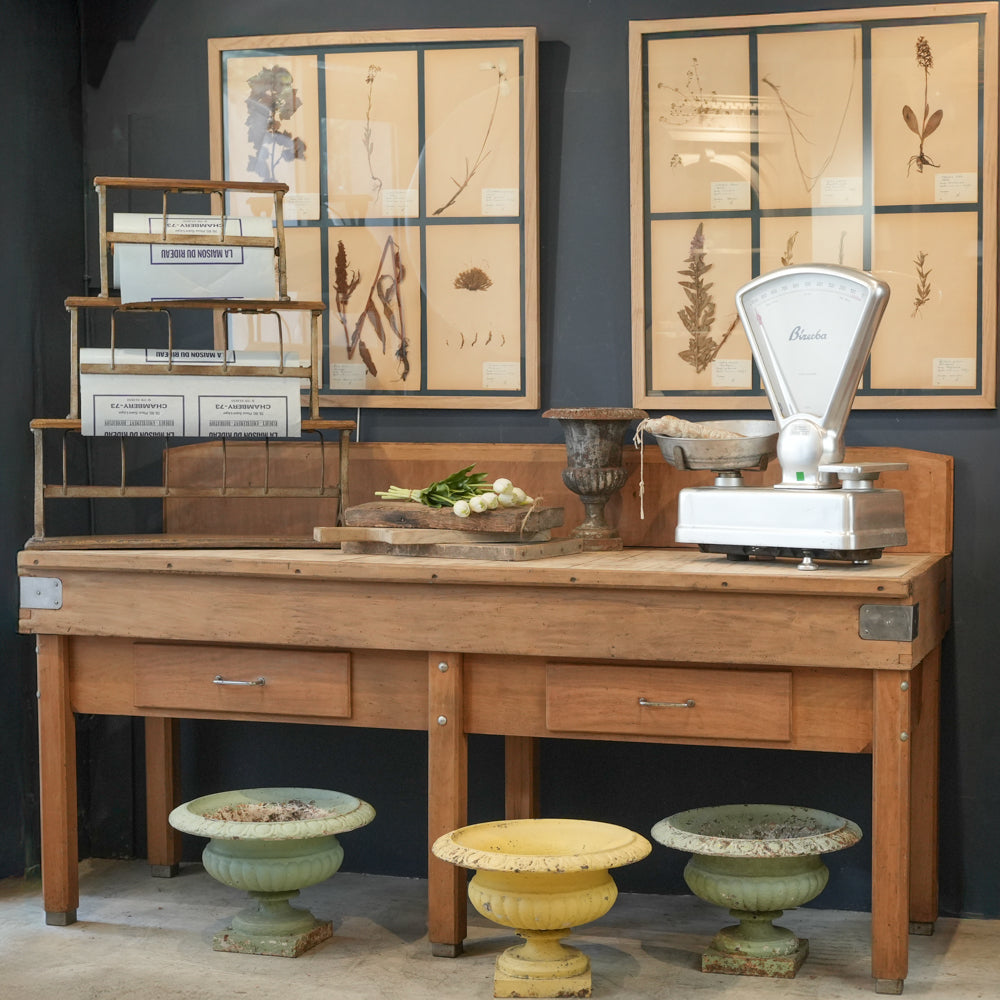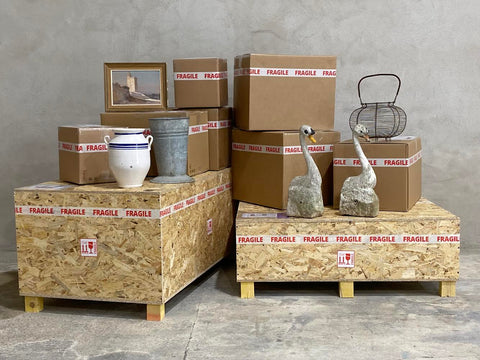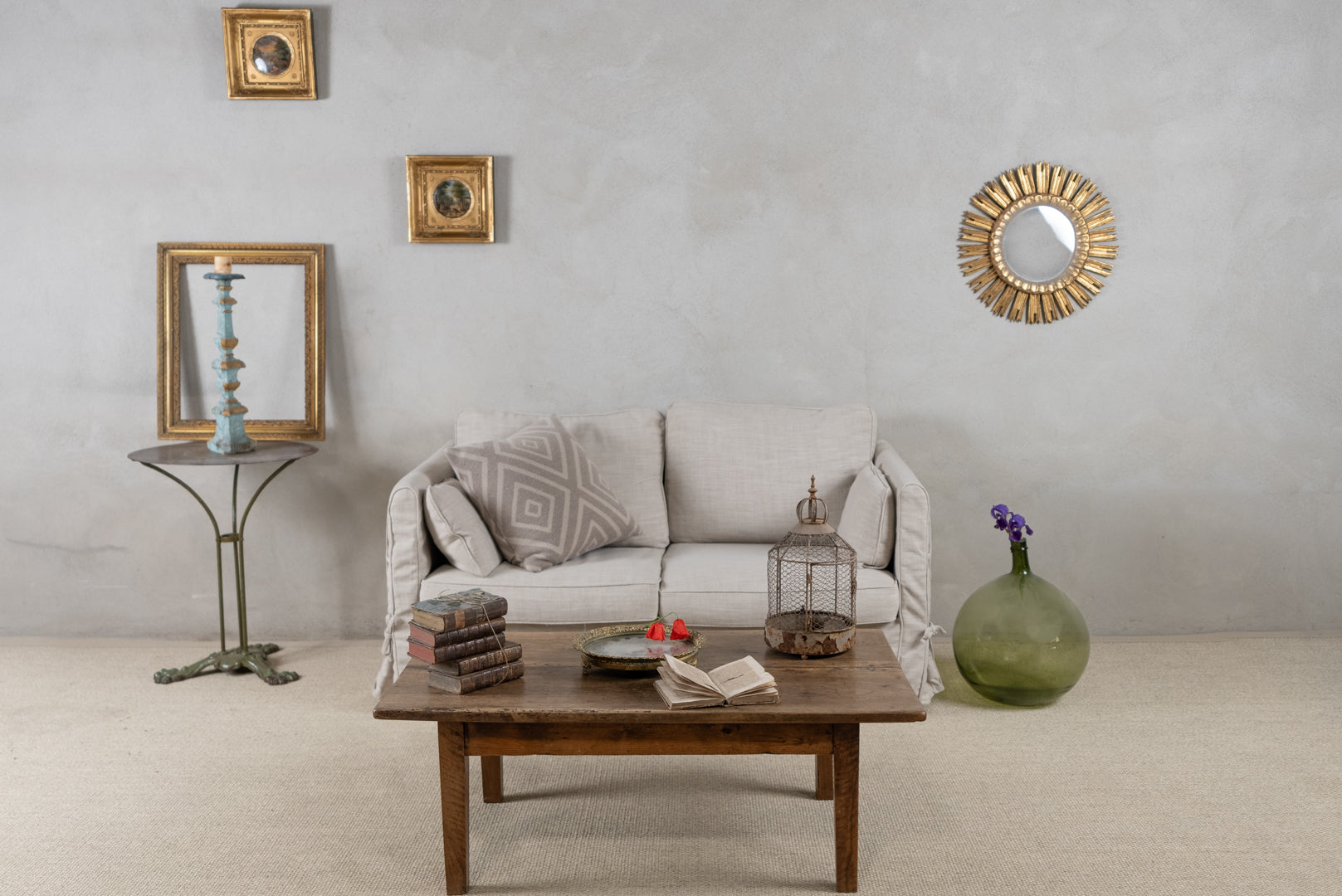
How to ship French antiques to USA in 2025
If you’re purchasing antique furniture, fine art, or sculptures in France, this comprehensive guide provides everything you need to know about shipping your items safely and efficiently worldwide. Whether you’re sending treasures to the US, USA, Canada, Asia, Australia, Europe, or the UK, these 18 essential tips will help ensure a seamless delivery experience.
At Chez Pluie, our shipping services are trusted by discerning clients around the globe and have been featured in worldwide press. Endorsed by local Tourism Offices and backed by a loyal clientele who repeatedly rely on us, shipping with Chez Pluie is the only way to ensure your French antiques are handled with care and expertise. From small parcels sent via air express to full shipping containers traveling by ocean freight, we guarantee peace of mind every step of the way.
Designed for private collectors and professionals alike, this guide covers every aspect of international shipping, including packaging, insurance, customs documentation, and logistics. Whether you’re furnishing a home in New York, decorating a space in London, or shipping to destinations like Tokyo or Sydney, Chez Pluie ensures your antiques arrive securely and on schedule.
For reliable, stress-free shipping with an impeccable track record, trust Chez Pluie to deliver your French treasures safely to your door.
Understanding transport costs used to be a challenging and time-consuming process. However, it’s now quick, transparent, and hassle-free with our complimentary transport quoting app, available on both the Apple App Store and Google Play Store.
This essential app is a must-have for serious buyers exploring antique markets, providing instant transport pricing for any item. With this powerful tool, shoppers can make fully informed purchase decisions on the spot, ensuring clarity and confidence when buying antiques. Learn more about how it works in Point 6.
How to ship French antiques to USA in 2025
- Understand the different services available
- Use only one service provider to source and ship your antiques
- When to use low-cost (and when not to)
- Packaging - small and fragile objects
- Packaging – crated items
- Instant shipping quotes - download the app
- Handling considerations
- Condition of furniture after purchase
- Essential preparation for delivery day
- Typical costs
- Make use of tax breaks
- Decide who pays import duties
- Understand who is responsible for customs clearance
- When receiving a quote, pay attention to your delivery address
- Understand insurance
- Common language
- Before arriving
- Where to buy antiques in France
1. Understand the different services available
It is important to choose the right service depending on your shipping volume and schedule. The most common services are (in order of volume):
Air express

Air freight

Sea/ocean freight - less than a container (LCL), or groupage*

- Some antique freight forwarders operate by filling their containers with smaller consignments exclusively from their customers. Depending on the destination, it may take months to fill a container, and many customers are left waiting with no firm timeframes given.
- A smaller consignment booked to be shipped within a shared container that is scheduled to depart on a certain date.
Sea/ocean freight - a full container (FCL)

2. Use only one service provider to source and ship your antiques
This ensures that a single company is responsible for everything promised to you – the quality of the furniture, the condition in which it arrives, the time frame, and the total cost.
Some shippers may only offer an international service to your nearest seaport. Then another contract is needed to make the final delivery to your door. Be very wary of this highly risky approach. If anything is damaged in transit, there is no clear indication of who is responsible.
Additionally, if the shipment is a full container, make sure the service includes having the container delivered to your door. If the service requires items to be unpacked from a container and repacked into a vehicle, this adds to the risk of damage in transit.
3. When to use low-cost (and when not to)
Low-cost shipping is a great solution for transporting new or artisan-made furniture, and when there is no strict project deadline. Low-cost shipping should be used in conjunction with a comprehensive insurance policy, as goods are much more likely to break in transit. When this happens, insurance covers replacements to be sent, and the only cost to the client is a delay in time.
However, this strategy does not work with antiques.
Antiques are irreplaceable and broken goods are lost forever. The best outcome to hope for is a refund, which puts the client back to square one. All the time spent shopping, selecting, and purchasing will have the be repeated over at the client’s expense.
For antiques, the best form of insurance is packaging. Professional packaging will cost a little more upfront, but it is by far the most effective way to reach the end goal of enjoying antique furniture in the home. Read more about packaging in the next two sections.
4. Packaging - small and fragile objects

Packaging is the single most important factor in furniture arriving safely. It is so important that we have allocated two sections to packaging!
Usually, the difference between a quality transport service and a low-cost service is the time and cost of packaging.
The lowest-cost shipping providers typically use minimal packaging, such as single-layer cartons and reused materials that are not fit-for-purpose. This is also the most common factor for breakages in transport. Unlike manufactured goods, antiques are irreplaceable, so quality packaging is essential.
For small and fragile objects, our business uses export-grade, double-walled cartons designed to carry 66lbs of weight. We make three layers of these, one inside the other, with crumple paper in between. Inside the innermost carton, we use a combination of self-moulding foam, tissue paper, bubble wrap, and crumple paper. This all depends on the object's shape, material, and finish.
5. Packaging – crated items

Any items that are too large for a carton will need to be crated. Crated items should always be fully enclosed. That is, a protective timber layer should cover all sides and top and bottom.
Any items which are only covered with plastic wrap, foam, or just timber framing are at high risk of breaking. Also, insurance companies typically will not cover this type of packaging.
The crates should also be reinforced to protect the objects from other heavy objects and machinery, such as forklifts. Inside, the objects should be protected with a mix of polystyrene, self-moulding foam, tissue paper, bubble wrap and crumple paper.
Often, the biggest risk of breakage can be from the object itself. For example, if the object is elongated and it experiences a whiplash force in transit, then it could crack under its own mass. This risk is mitigated with expert placement of timber supports at various points creating a counter pressure. The force applied by these supports then needs to be precisely calibrated with foam inserts.




6. Instant shipping quotes when making furniture purchase decisions - download the app
When antique shopping in France, clients who are shipping less than a container will have to take into account the additional shipping cost of each item as they make their purchase decisions.
The only instant way to do this is by using our transport quoting app. It can be downloaded from both the Apple app store and Android Store.
For example, a client may have already purchased some pottery, glassware, bar stools, and some paintings, and they know their shipping costs for these items. However, they then spot a large oak dining table. If they purchase the table, it is going to change the shipping service and the overall cost of the shipping for all their goods. The additional shipping cost will be significant, so how do they find this out prior to making a well-informed purchase decision? The only way to know your shipping costs for each item is with our app.
7. Handling considerations

A client will typically buy furniture from several different dealers. Then, it is the transporter’s responsibility to collect furniture from the dealer, use their own vehicles to bring furniture back to their warehouse, store the items, prepare the furniture for international shipment, then dispatch the packaged goods with a forwarder. This is a lot of handling by various individuals, and it is extremely important to manage the risk of breakage at all times.
At Chez Pluie, these risks are managed as follows:
- Handling procedures have been written and refined over time, and we have regular team meetings to assess ways to improve these.
- All of our staff are trained from the ground up, and none have worked for other transporters – we do not want to inherit bad habits such as rushed or improvised handling of precious antiques.
- Our staff are provided with the correct handling tools, and we ensure all equipment is fit for purpose.
- Every staff member’s remuneration is tied to a key performance metric of not damaging any inventory. This is measured weekly, and a significant proportion of their salary is at risk, so they will protect every item they handle.
8. Condition of furniture after purchasing and before the collection

Quite often, much time can pass between when the client makes a purchase and when they instruct the transporters to proceed with collections. This is mostly due to the time it takes to confirm the entire list of items to be purchased, and to finalise the transactions.
During this time, purchased items remain with the antique dealers. The furniture either remains on the dealer’s shop floor or is stored in the dealer’s depot.
There is a chance that damage can occur to the furniture during this time.
This is why the transporter should always provide a condition report to the client at the time of collection. The condition report should include photos and descriptions of any irregularities.
More importantly though, the transporter should actively assist the client with resolving any discrepancies with the condition. To do this, it is imperative for the transporter to have an excellent rapport with the antique dealers. This will help with coordinating any repairs or restorations.
For the client, it is a far better outcome if these issues are resolved in France prior to the furniture being shipped to the USA.
9. Essential preparation for delivery day
When recieving any goods it is important to thoroughly check the condition of the goods as soon as possible. Ideally any damage should be reported to the delivery person, however it can also be reported for a short time afterwards. If there is any visible damage to the packaging, take photos of this before opening the parcel or crate. If there is damage, generally, the more photos the better.
Air freight
Airfreight will typcially be delivered to your door, unloaded from a truck and handed over at the entrance to the delivery address. The items will be packaged in fully enclosed timber cases which are too heavy to lift by hand. It is highly recommended to have:
- basic hand tools such as an electric drill to open the crates
- enough people to assist with moving the items into their final position, or
- moving tools such as a trolley
- a plan in place in case of wet weather
Sea/ocean freight - a full container (FCL)
The standard arrangement for delivery of a container to the destination address is as follows. This applies to both business and personal container deliveries.
The address must have adequate access for a large truck to arrive, park, remain stationary and depart. The container stays on the truck trailer. The truck and driver remain on site for two hours, and after that an hourly rate applies for the truck to stay longer. The driver does not help with unloading the truck - this is their designated rest time.
Usually the recipient will have pre-arranged a team of people available onsite to unload the container. The container stays on the trailer so the floor of the container is about 5’2” above ground level. The team of unloaders is usually seperate from the container delivery scope, and it is important to confirm who is responsible for this with the shipper in advance.
Depending on what furniture is purchased, it may be possible to unload the container with four strong people. Otherwise the items are large, heavy objects, then a lifting trolley or forklift would be requried.
The exact process will also depend if the furniture is being moved into a house right away, or into storage. In the event of bad weather, then ensure to have a solution for moving the furniture to a dry place immediately.
Once the container is unloaded, the driver leaves the site, taking the container away.
10. Typical costs
Transport costs vary by time, volume, destination, and type of goods shipped. For example, a 35 cubic foot armchair will be far simpler to prepare and package than a 35 cubic foot chandelier. Also, global shipping rates prior to, during, and post-COVID have fluctuated enormously.
Nonetheless, to provide a general guide, here are some price ranges that should help guide your budget. These are based on some of our recent previous shipments in 2025.
| Type of goods shipped | Service Used | Example Contents | Price Guidance |
|---|---|---|---|
| Full Container | Ocean Freight FCL | 6-piece sofa, 1 bookcase, 10-seater dining table, 7 armchairs, 1 very large metallic sculpture, 3 commodes, 1 large trunk, 2 large chandeliers, 3 light fixtures, 2 large mirrors, several lots of small decorative objects. | US$15,000-$20,000 |
| 3 Large Crates | Ocean Freight FCL | 5 armchairs, 2 large Trumeau mirrors, 1 large wall pane, 1 decorative barometer. | US$4,000–$5,000 |
| 1 Large Crate | Air Freight | 1 large antique commode. | US$1,000–$2,000 |
| 4 Cartons | Air Express | 1 pair of cache-pots and 1 pair of ceramic vases. | US$500–$800 |
| 1 Small Crate | Air Express | 2 medium sized paintings. | US$400–$600 |
A full container to Dallas, Texas
- Service: Ocean Freight FCL
- Example contents: Six-piece sofa, a bookcase, ten-seater dining table, seven armchairs, a very large metallic sculpture, three commodes, a large trunk, two large chandeliers, three light fixtures, two large mirrors, several lots of small decorative objects.
- Price guidance: US$15,000-$20,000
Three large crates delivered to Texas
- Service: Ocean Freight LCL
- Example contents: Five armchairs, two large Trumeau mirrors, one large wall pane, one decorative barometer
- Price guidance: US$4,000-$5,000
One large crate delivered to Connecticut
- Service: Air Freight
- Example contents: One large antique commode
- Price guidance: US$1,000-$2,000
Four cartons delivered to New York
- Service: Air Express
- Example contents: A pair of cachepots and a pair of ceramic vases
- Price guidance: US$500-800
Small crate delivered to Mississippi
- Service: Air Express
- Example contents : Two medium sized paintings
- Price guidance: US$400-600
11. Make use of tax breaks

If antique dealers in France can prove that their sold goods have left Europe, then they pay less tax (TVA in France). This is why clients from overseas ask dealers for “the export price”. However, only the shipper can provide proof that the goods have been exported. Therefore, it is so important that the shipper has a good rapport with the antique dealers. This way, the antique dealers can comfortably discount the tax from their prices, without fear that they will not receive their all-important “Proof of export certificate.” As such, choosing the right shipper will help you save on the purchase cost of your items.
12. Decide who pays import duties
International customs processing is far more automated today than in the past, so you should expect export/import clearance to be a standard service.
It is important to note that antiques older than 100 years of age can be imported into the USA free of duties. Nonetheless, this section is relevant if a shipment contains any new items, and it is important to decide upfront who covers the import taxes and duties. Either:
- Shipper pays - the shipper can provide an all-up quote, including all duties and import taxes. For buyers, this is a slightly higher overall cost, but also offers peace-of-mind of knowing all costs upfront.
- Recipient pays - duties are paid directly to the destination government when the furniture arrives in the country. If the recipient is a business, it is often possible to receive tax credits depending on the import country.
13. Understand who is responsible for customs clearance

In most cases, a reputable shipper will complete the customs clearance for their clients, but it is still worth asking this question.
However, it is really important to note that some forms have to be filled out by the client. One example of this is the 5016 Create Importer Identity Form, which is required by US Customs and Border Protection authority. This is a relatively simple form to complete, but there is one catch…
This form must be completed within 5 business days of the goods arriving on US soil, or the US CBP will deport the goods.
This is why you should always use a reliable transporter who communicates in advance and has systems in place to ensure your goods are not deported.
14. When receiving a quote, pay attention to your delivery address
This may sound obvious, but most international shipping companies only deliver to the nearest seaport or distribution centre. Pay close attention to any quotes provided to ensure the delivery address is what you expect it to be.
15. Understand insurance

If antiques are well packaged and sent with a reliable shipper, then damaged items are a rare occurrence. Nonetheless, here are three points to check with any shipping insurance offer:
- How much are the goods insured for? i.e., just the buy price, or including shipping cost as well.
- How quickly must a breakage be reported?
- If an object can be repaired, how does this work?
16. Common language
Shipping antiques internationally requires a lot of communication between the client and transporter. Therefore, it is best to choose a transporter who speaks the same language – this will remove a lot of complications and risk of misunderstanding. Also, general business cultures are different around the world, so it is important to work with a transporter who understands the service level expected in the USA. For example, a transporter who works in the USA time zones, in US dollars and will respond to questions and requests in a timely manner.
17. Before arriving
Prepare in advance with a general shopping list, and importantly, measurements - no matter how beautiful an item is, it must fit the space you have in mind! Also, take many photos of rooms in your home from all angles. Have the photos ready on your phone – these will be invaluable when shopping in France.
18. Where to buy antiques in France

Our favourite region is in the south of France. There are possibilities to purchase all over France, but we recommend coming to L’isle-sur-la-Sorgue, in the heart of Provence. Not only is it a beautiful part of the world, but it is also home to the largest antique market outside of Paris. There is an exceptional range available, and prices are more forgiving than in Paris.
Have fun
Remember that buying antiques from France is a delightful, exciting, and memorable experience. By choosing an excellent transport service provider, the shipping will also be easy and reliable.








2 comments
Bon Jour,
Is the app free to use?
Leslie
Leslie
Yes
Patrick Balmitgère
Leave a comment
This site is protected by hCaptcha and the hCaptcha Privacy Policy and Terms of Service apply.